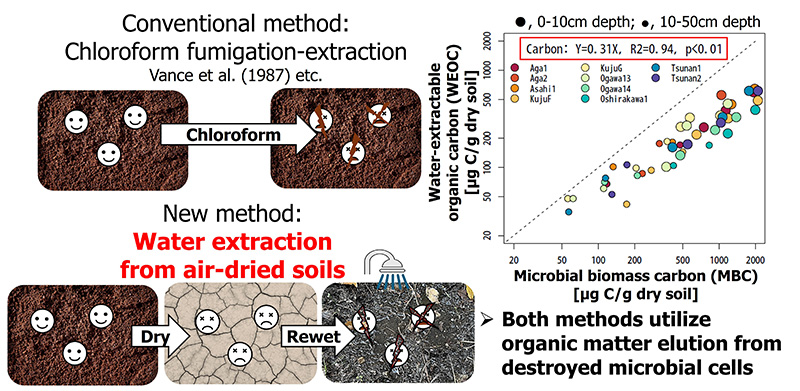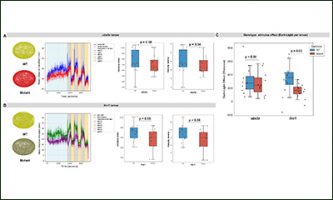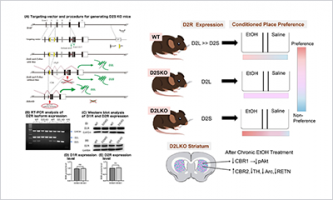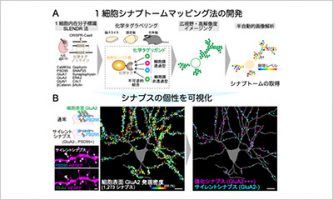Estimating Microbial Biomass from Air-Dried Soils: A Safer, Scalable Approach ーRevolutionary Technique Estimates Soil Microbial Biomass Using Water-Extractable Organic Matterー
Jun 26 2025
In a remarkable advancement for soil science, researchers from Japan have developed a novel method for estimating microbial biomass using water-extractable organic matter (WEOM) from air-dried soils. This innovative approach not only simplifies the estimation process but also eliminates the need for toxic solvents typically used in traditional methods, such as chloroform fumigation extraction.
A research was conducted by a dedicated team from Niigata University, Kyushu University, Japan Atomic Energy Agency, and Anhui Academy of Agricultural Sciences researchers. The study analyzed 50 soil samples from ten diverse profiles across various regions in Japan, including six forests and one pasture. The researchers aimed to evaluate the relationship between WEOM measurements and microbial biomass, focusing on both carbon and nitrogen content.
The findings revealed a strong correlation between the amount of water-extractable organic carbon obtained from air-dried soils and microbial biomass carbon, with a squared correlation coefficient (R2) of 0.94 and a statistical probability (P) of less than 0.01. This indicates that WEOM can serve as a reliable estimate of microbial biomass, particularly for carbon content, which is crucial for understanding soil health and ecosystem functioning.
Moreover, the study highlighted that the relationships between WEOM and microbial biomass carbon were consistent with soil physicochemical properties, achieving an R2 of 1.00 and a root mean square error (RMSE) of just 0.04. In contrast, the correlation between water-extractable total nitrogen and microbial biomass nitrogen was weaker, with an R2 and RMSE of 0.73 and 0.28, respectively. This discrepancy was attributed to differences in inorganic nitrogen compounds present in the soil extracts.
Dr. Hirohiko Nagano, one of the lead researchers, stated, "This new method allows microbial biomass to be estimated from archived air-dried soil samples, even when fresh soil is unavailable. Furthermore, it can also be applied in environments where hazardous chemicals are restricted, since it does not require the use of toxic substances. As a result, we expect that this approach has the potential to dramatically accelerate the construction of large-scale datasets on soil microbial biomass."
The implications of this research are profound. By utilizing air-dried soils, researchers can avoid the complexities and hazards associated with traditional methods, making microbial biomass estimation more accessible and practical for a wider range of studies. This method not only enhances our understanding of soil microbiology but also paves the way for more sustainable practices in environmental research and agriculture.
Prof. Syuntaro Hiradate another member from the research team further emphasized the broader impact of this research, saying, "The ability to estimate microbial biomass without the need for fresh samples or toxic solvents opens new avenues for research in remote or sensitive environments. This could lead to a better understanding of microbial roles in various ecosystems and inform conservation efforts."
While the authors caution that this method remains an empirical estimation requiring further validation across diverse soil samples, the potential for this innovative approach to transform soil science is undeniable. Future research will be essential to confirm its applicability in different soil types and environmental conditions.
This ground-breaking method for estimating microbial biomass represents a significant step forward in soil science, providing researchers with a safer and more efficient tool for studying the vital role of microorganisms in soil health and ecosystem dynamics. As the scientific community continues to explore the potential of WEOM, this study marks a pivotal moment in the mission for sustainable and effective soil management practices.

Fig 1. Air-Drying and Rewetting: A Safer Alternative to Chloroform in Soil Microbial Biomass Estimation
In Compares a traditional (top) and a new innovative method (bottom) for estimating microbial biomass carbon (MBC) in soils. The new approach uses air-drying and rewetting instead of toxic chemicals and shows strong results—making it a safer, low-cost, and effective alternative.
Publication Details
Journal: Discover Soil
Title:Estimation of microbial biomass based on water-extractable organic matter from air-dried soils from Japanese forests and pasture
Authors:Hirohiko Nagano, Yuki Kanda, Yuri Suzuki, Syuntaro Hiradate, Jun Koarashi, Mariko Atarashi-Andoh, Zhibin Guo
Doi: 10.1007/s44378-025-00053-4
News release
The article was released in EurekAlert, the online publication of the American Association for the Advancement of Science.
More News
-
 Dec 08 2025 Research results
Dec 08 2025 Research resultsBehavioral and molecular insights into anxiety in ube3a and fmr1 zebrafish models of autism spectrum disorders
-
 Nov 18 2025 Research results
Nov 18 2025 Research resultsDopamine D2S/D2L Receptor Regulation of Alcohol-Induced Reward and Signaling
-
 Nov 17 2025 Research results
Nov 17 2025 Research resultsSingle-cell synaptome mapping of endogenous protein subpopulations in mammalian brain
